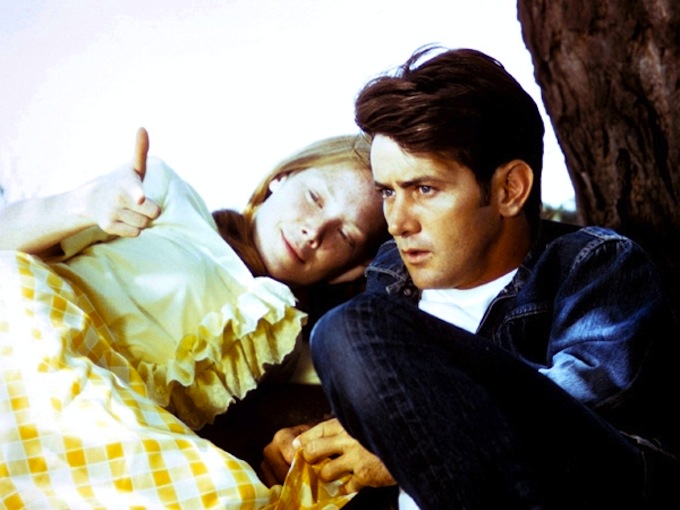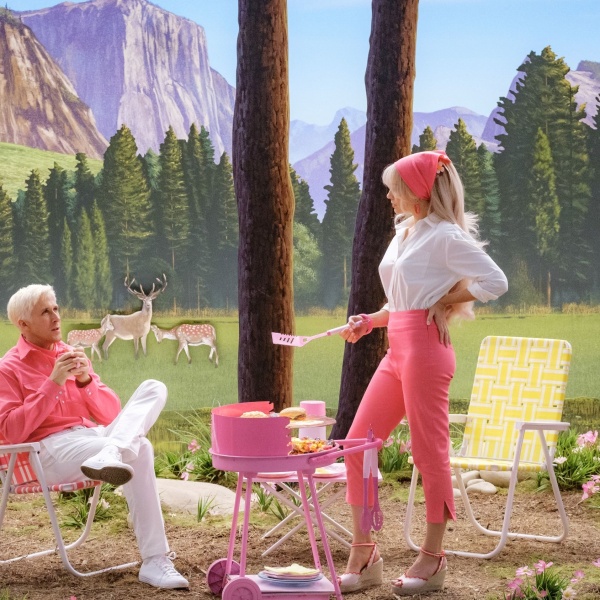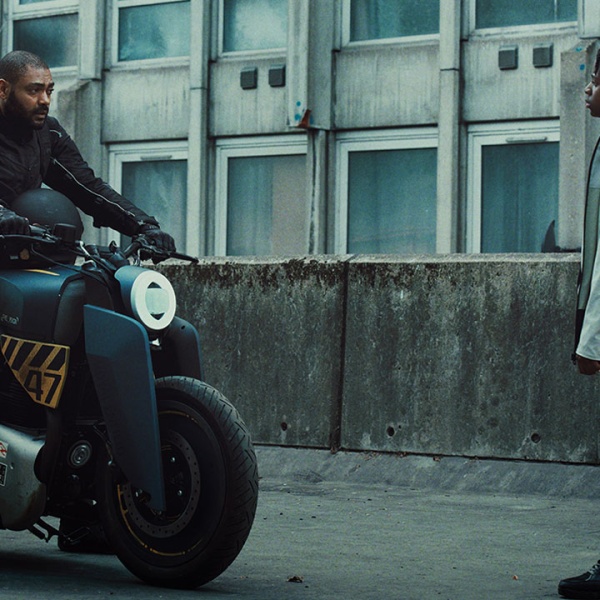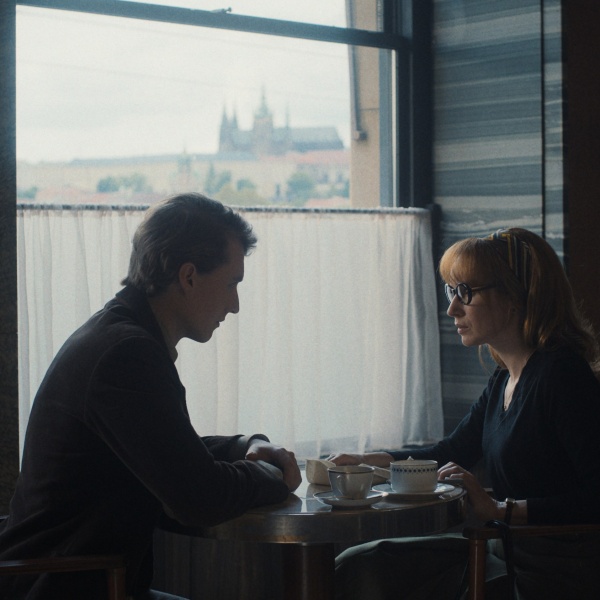It has been almost four decades since Terrence Malick‘s debut feature film “Badlands” and if you haven’t seen the film in a little while, it’s just as good you remembered it. Starring Martin Sheen and Sissy Spacek, “Badlands” sounds about as un-Malick-esque as you can get. Loosely based on the true story of Charlie Starkweather and his 14-year old girlfriend Caril Ann Fugate who went on a two-month road trip through Nebraska and Wyoming in 1958 and stacked up eleven murders, Malick re-imagines them as Kit and Holly, but this isn’t your standard “Bonnie & Clyde” styled flick. Lyrical, enigmatic and pastoral, frame-by-frame the style and tone that Malick would become famous for makes its presence known. In fact, revisiting the film, one can almost see thematic parallels between “Badlands” and “The Tree of Life.” Arguably, Kit and Holly represent “nature and grace” in their own way; Malick’s penchant for nature as an unspoken force is definitely felt and more superficially, Jessica Chastain looks disarmingly like a young Sissy Spacek.
In the lead up to the national release of “The Tree of Life,” week-by-week, we’re getting reacquainted with the films of Terrence Malick, researching as much as we can and hopefully presenting you with some things you may not have known about them beforehand. We tackled Malick’s latest effort last week — you can read it here if you missed it — and this week we go all the way back to the beginning. So here’s eleven things we learned about “Badlands.”

01. This is not Terrence Malick’s first film, that honor belongs to the 17-minute “Lanton Mills.”
While “Badlands” is the first feature film completed by Terrence Malick, his debut effort behind the camera in the form of the curious, seventeen minute long “Lanton Mills.” Even the most diehard Malick-heads are unlikely to have seen it or ever see it. Now housed at the American Film Institute where it is viewable by students only who are unable to check it out or copy it — it must be viewed on the premises — Theresa Schwartzman at Rohstoff Filmmagazin managed to take a look and the first thing that will surprise many is that it’s an outright comedy. Starring Harry Dean Stanton, Warren Oates (who would also feature in “Badlands”) and Malick himself, the story follows “two cowboys (Malick as Tilman and Stanton as Lanton Mills) who set off on horseback to rob a bank. On the way, they stop to see their boss, the Old Man, only to discover he has been murdered by another cowboy, John Sparks (Oates).” Schwartzman describes “Lanton Mills” as “an extremely ‘talky’ film and most of that talk teeters on the edge of vaudeville or jabberwocky” but she does note “it is rich in elements that would become Malick’s trademarks. Daylight assumes a tactile presence — though here it is not the diffuse ‘magic hour’ light (i.e., Malick-light) of later films, but a bold late afternoon sun that streams through leaves, creating shadow and dappled highlight on the characters’ faces. The camera angles tend to be either wide or wider, even in dialogue scenes. Also familiar from Malick’s later films is the attention to landscape and nature — a few hens strut past Warren Oates as he is shot and a humongous pig noses around him as he dies.” So a gorgeously lensed, talkative comedy about two cowboys? Maybe Malick should follow-up on that “Zoolander” love and direct the sequel.
02. And before “Lanton Mills,” Terrence Malick was a staff writer at the New Yorker before deciding to become a filmmaker.
A Rhodes Scholar and Harvard philosophy major, Terrence Malick briefly toyed with a journalism career. Richard Brody of the New Yorker spoke with Malick’s classmate Jake Brackman who recalled that the auteur first worked for Life magazine, covering Latin America before moving to the New Yorker where he had an office from 1968-1969 (he also had a brief stint at Newsweek). His biggest piece of writing — that of course, he never finished — was centered on the imprisoned French philosopher Régis Debray who had been working with Che Guevara. Paul Lee, a philosophy instructor at Harvard and MIT told GQ, “I have a memory of it piling up to six feet of copy. He got obsessed, and he overwrote, and he went past it. He never finished it.” However, Malick and Brackman did team on a piece that was completed about the assassination of Martin Luther King Jr. published in the April 13, 1968 issue of the magazine which you can read right here with a subscription.
Eventually, Malick migrated over to films with Lee recounting, “I remember meeting him on a corner in Cambridge, and he told me he wanted to go to film school in California. I almost hit him. I said, ‘You’d give up a promising career in philosophy—even more promising than my own—to go and do movies?’ I really was gonna knock him down. I was so appalled that he would stoop to that.” As for Malick, he figured filmmaking was a good as any other job telling Sight & Sound (in what appears to be the last ever interview he conducted in 1975), “I was not a good teacher; I didn’t have the sort of edge one should have on the students, so I decided to do something else. I’d always liked movies in a kind of naive way. They seemed no less improbable a career than anything else. I came to Los Angeles in the fall of 1969 to study at the AFI.” Hence, “Lanton Mills” now being archived at the school.
Before getting started on “Badlands,” Malick earned some coin with early script writing assignments. He earned a credit on the Paul Newman/Lee Marvin western “Pocket Money,” did some uncredited work on Jack Nicholson‘s directorial debut “Drive He, Said” and, believe it or not, he even worked on an early draft of “Dirty Harry.” But most trivia worthy, one of Malick’s scripts — the comedy “Deadhead Mile” — was made into a film starring Alan Arkin, Richard Kiel, Hector Elizondo among others and interestingly enough Ido Lupino and George Raft as themselves. But directed by Vernon Zimmerman, it was considered so bad, Paramount Pictures has never officially released it (though if you’re curious, you can snag a bootleg).
03. Terrence Malick says classic literature was the primary influence on “Badlands.”
While legendary New York Times critic Vincent Canby in his glowing review of “Badlands” drew a line to Arthur Penn‘s “Bonnie and Clyde” and Fritz Lang‘s “Fury” and “You Only Live Once” and Roger Ebert compared the film to Robert Altman‘s “Thieves Like Us” and Steven Spielberg‘s “The Sugarland Express,” Malick himself revealed to Sight & Sound magazine that his inspirations didn’t come from any celluloid.
“The critics talked about influences on the picture and in most cases referred to films I had never seen,” he said. “My influences were books like ‘The Hardy Boys,’ ‘Swiss Family Robinson,’ ‘Tom Sawyer,’ ‘Huck Finn‘–all involving an innocent in a drama over his or her head. I didn’t actually think about those books before I did the script, but it’s obvious to me now. ‘Nancy Drew,’ the children’s story child detective–I did think about her.”
“You should always feel there are large parts of [Holly’s] experience she’s not including because she has a strong, if misplaced, sense of propriety,” Malick explained in the same interview. “You might well wonder how anyone going through what she does could be at all concerned with proprieties. But she is. And her kind of cliché didn’t begin with pulp magazines, as some critics have suggested. It exists in ‘Nancy Drew’ and ‘Tom Sawyer.’ It’s not the mark of a diminished, pulp-fed mind, I’m trying to say, but of the ‘innocent abroad.’ When people express what is most important to them, it often comes out in clichés. That doesn’t make them laughable; it’s something tender about them. As though in struggling to reach what’s most personal about them they could only come up with what’s most public.
But it’s a particularly intangible quality that Malick ultimately found in those books that infused his film. “Nostalgia is a powerful feeling; it can drown out anything. I wanted the picture to set up like a fairy tale, outside time, like ‘Treasure Island.’ I hoped this would, among other things, take a little of the sharpness out of the violence but still keep its dreamy quality. Children’s books are full of violence. Long John Silver slits the throats of the faithful crew. Kit and Holly even think of themselves as living in a fairy tale. Holly says, ‘Sometimes I wished I could fall asleep and be taken off to some magical land, but this never happened.’ But she believes enough there is such a place that she must confess to you she never got there.”
04. Martin Sheen was initially considered to be too old for the role of Charlie Starkweather.
Casting director Diane Crittenden recalls to GQ, “We were looking for a James Dean character, basically. Somebody confident and a bit narcissistic, and Marty Sheen came to mind, but Terry didn’t think that would fly. He thought he was too old.” But not only that, he nearly didn’t even bother reading for the part.
“I went to this hotel on Sunset Boulevard one day to read for a commercial for a haberdashery. Afterwards, as I headed toward my car, this woman is pounding on the window of the first floor of the hotel, trying to get my attention,” Sheen said to GQ. Crittenden adds, “I ran up to him and said, ‘I’m doing this great script. You should come in and read for it.’ He said, ‘Look, if it’s an independent film with no money, I’m not interested.’ And I said, ‘But it’s so good!’”
At a recent screening of “Badlands” at the LACMA, Sissy Spacek confirmed that Sheen was not the first choice. “I was cast first, and I got to do scenes with every good looking actor in Hollywood, and Terry said, ‘we have to meet with this guy as a favor, but he’s too old.’ That was Martin Sheen, and it was obvious immediately. From the moment we met him he was Kit, he had the boots and everything,” reports ScreenCrave.
But Sheen loved the material and nailed the audition with Spacek telling GQ, “Here I was ready to be nice, and Martin came in, and he just blew us away. I’d been doing the scene over and over with different actors, and it just changed everything. I felt like a thirteen-year-old schoolgirl twirling a baton in my front yard. We were giddy.”
05. Malick’s style was not everyone’s cup of tea and the lengthy and difficult shoot saw three cinematographers, numerous editors and sound men come and go on “Badlands.”
Terrence Malick’s unorthodox, intuitive and open-ended shooting schedule and production style is now the stuff of legend and it was evident from his very first film. “The shoot went on forever because the crew kept quitting,” Spacek told The Guardian. “They were completely brutalized. They’d be setting up one shot over here, then Terry would look over in the other direction where the moon was rising up and he’d go, ‘Let’s shoot over there!’ I have these memories of everyone tearing off across the desert in pursuit of one sunset or another.”
The Best Boy on the film Doug Knapp recalls to GQ, “The first unit must have run three and a half months, and then they did another month to two months of second-unit work with a completely different crew. For a small film, that’s a long time. And the amount of film that was shot—I heard over a million feet on the first unit. More typical for a smaller film would be 250,000 to maybe 500,000 feet. I know they shot a lot on the second unit as well. Terry didn’t seem to know very much about running the camera other than ‘It’s time to reload again, isn’t it?’ He would reload a lot.”
“It just went on and on. Terry just kept shooting. He was about ready to lose his whole shooting crew. It was almost like Mutiny on the Bounty,” actress Janit Baldwin recalls to GQ (her scenes were cut from the final film much to her shock). “He probably shot enough film to make five pictures,” said actor Gary Littlejohn with Assistant Director Bill Scott noting, “There were days that we were knocking down 10,000 feet [of film].” So no surprise, the editing on the film took another ten months, but that’s the process Malick appears to love the most.
“We were in the editing room on ‘Badlands’ for ten months. It was a long time,” Associate Editor and now longtime Malick associate Billy Weber recalled to GQ.” Terry loves editing. More than shooting. In the editing room, you feel like you’re not being rushed into decisions. We put in twelve to fourteen hours a day.” And despite all the people that had their hands in the pot, the final result is pure Malick.
“There were three cinematographers [Brian Probyn, Tak Fujimoto and finally Stevan Larner], lots of editors, sound men,” Art Director and another longtime Malick collaborator Jack Fisk told the Guardian. “Except for the actors, the art department was the only one that completed the film. If the picture survived all those problems, it’s because one thing was consistent: Terry Malick’s vision.”
And on Malick’s subsequent films, his penchant for cycling through numerous members of technical staff would continue. “The Tree of Life” has five credited editors, “The Thin Red Line” has three and “The New World” comes in at four.
06. Terrence Malick went at least $35,000 over budget due to the ever expanding shoot (and was probably not helped by the massive fire on set).
“Badlands” had the tiny budget and difficulties most independent productions face — it was budgeted at $300,000 with producer Edward R. Pressman who put in half, with Malick putting in $25,000 of his own money and raising the rest — but Malick’s organic shooting approach eventually caused the production to go over budget.
But according to Billy Weber on the Criterion edition of “Days Of Heaven,” “Badlands” was made for $350,000 and was bought by Warner Bros. for $900. It was actually shot for $700,000, but $350,000 in costs was deferred until later. “Everyone got paid, but it never made money, it never turned a profit,” Weber said on the disc.
“We were shooting tons of film, which we were not budgeted to shoot. And our schedule was getting extended, which we were not budgeted for,” assistant director Bill Scott told GQ. But it wasn’t just Malick’s own habits that caused costs to rise as a fire on the set likely didn’t help matters. During the scene in which Charlie burns down Holly’s home, three cameras were destroyed and sent at least one person to the hospital.
“Everyone could smell the fumes and we were getting light-headed. Roger [George, special effects]’s assistant lit the torch and said, ‘Are you ready?’ The next thing I remember hearing was a WHOOSH! And I just turned the camera on. I thought this was planned,” recalls Best Boy Doug Knapp. “I bailed out the door. Roger was completely surrounded by flames.”
“I remember seeing Roger on the ground outside later, wrapped. He was a real mess. The local hospital wasn’t equipped to handle him, and there was concern about the great expense of getting him a medical helicopter, but they realized there was no choice. They flew him back to the Sherman Oaks Hospital,” Knapp continues. “All the cameras were engulfed and destroyed. The fire strained relationships, and there were lawsuits afterwards. People were wondering if they were gonna get paid, and they started leaving,” said Tony Palmieri who worked the Assistant Camera. “We were down to maybe five crew members.”
The film wound up going $35,000 over budget, forcing Malick to take writing assignments to help pay for the editing of the film. Yet despite the complications, production plowed on and even now as Malick gets more money and resources to work with, great efforts are taken to keep an intimate feel on set. “The movies and the budgets have gotten bigger, and we take pains to hide stuff from him, so he doesn’t see how many trucks are parked around the corner. Because it doesn’t help him,” says Jack Fisk. But that doesn’t really matter. Malick would be happy shooting film all by himself.
“I don’t think Terry ever finished. I think we all left him in the desert alone,” Palmieri says. Fisk adds, “I think when he left it was snowing. He stayed after everybody else, still shooting. He doesn’t like to stop.”
07. Terrence Malick and producer Lou Stroller got into a fist-fight on the set of the movie.
While Terrence Malick’s faithful actors and crew members stayed with the film through thick and thin, producer Lou Stroller was feeling the effects of Malick’s unorthodox methods.
“Lou realized more than anyone how dangerous circumstances were, given our budget,” Assistant Director Bill Scott told GQ and eventually Stroller and Malick literally came to blows.
“Lou Stroller made some comment about Mrs. Malick, and Terry was not having it, and beat the hell out of him. In true Texas style—he was so Texas. Didn’t even hesitate, just started swinging,” Martin Sheen recalls. “They were down like two buffalo—they were big guys—and they were on the ground, rolling around, and Terry just whupped him. Oh, I acted outraged—’What a breakdown of discipline, this fighting on the set!’—but I couldn’t have been prouder of him. Can you imagine? If more directors would beat up their producers, we’d have a lot more artistic freedom.
08. Classmate Edward Brackman claims the extensive voiceover was used to patch up holes in the narrative.
The audience is guided on the strange journey by Holly and Kit in “Badlands” by Sissy Spacek‘s evocative and not particularly plot driven voiceover, but according to Jake Brackman, it was more by necessity than design. “There were so many holes in the storytelling because of the constraints and difficulties of the shooting that it entailed a tremendous amount of fooling around with the voice-over to tell the story, and also to conceal the expositional nature of the voice-over by putting in a lot of oblique voice-over that was not at all expositional,” he told GQ. “It was like patching the holes in the road.”
But speaking to Sight & Sound, Malick says he had a very specific purpose for Holly’s narration. “There is some humor in the picture, I believe. Not jokes. It lies in Holly’s mis-estimation of her audience, of what they will be interested in or ready to believe. She seems at times to think of her narration as like what you get in audio-visual courses in high school. When they’re crossing the badlands, instead of telling us what’s going on between Kit and herself, or anything of what we’d like and have to know, she describes what they ate and what it tasted like, as though we might be planning a similar trip and appreciate her experience, this way.”
And certainly, to this day, both Spacek and Sheen relish even the brief morsels of dialogue they got in the film. “The way he used narration was so amazing. On the screen, you’d see the flattest, most uninteresting landscape you’ve ever seen in your life, and the voice-over would be, “Kit told me to enjoy the scenery. I did.’ Or ‘Kit shot a football. He said it was excess baggage.’ I don’t typically remember dialogue years after making a film, but periodically in life, someone says something, or something happens, and I’ll get a cue from ‘Badlands.’” Spacek told GQ. Sheen adds, “I couldn’t tell you what I said yesterday, but that dialogue, oh yeah. Easily. Easily.”
09. Terrence Malick makes a cameo in the film.
The reclusive, press shy director did the unthinkable and actually appeared in “Badlands.” It’s hard to believe but as Martin Sheen recalled to GQ, the director stepped in when an actor didn’t show and had serious thoughts about re-shooting the scene with the actor convincing him not to. “One day an actor didn’t show up to play a part, so Terry did. He’s so self-conscious, and he did not want to be in the film, and he told me he was going to re-shoot his character. I assured him that I would never shoot that scene with anyone but him. We’d had this extraordinary time together, and I knew that he would never go on camera again the rest of his career,” Sheen said. Take a look at the scene below (via FILMdetail).

10. Those behind the film aren’t convinced Warner Bros. knew what they had when they picked up “Badlands” after it premiered to rave reviews at the New York Film Festival.
While we’re only left with anecdotal evidence, by most accounts “Badlands” was the star of the New York Film Festival where another film you might have heard of, Martin Scorsese‘s “Mean Streets,” also premiered. Peter Biskind in Vanity Fair says Malick’s film wound up “overshadowing” Scorsese’s effort, with the Guardian saying pretty much the exact same. But either way, Warner Bros. knew there was something great about both films and picked them up, though to hear it now, “Badlands” might have disappeared into obscurity.
“We saw it and we were knocked out by it. It was a new voice, as far as I was concerned,” former Warner Bros. President John Calley told GQ, maintaining they liked the film as is. “I don’t think we would have dared ask for changes. It would be like calling Fellini and saying, ‘Hey, Fred, I think she should have bigger tits.’”
But Jack Fisk is less convinced that Warner Bros. — who GQ says paid $1 million for “Badlands” and picked up “Mean Streets” on the same day — knew what they there dealing with. “I think that Warner Bros. didn’t really know what they had. Terry had done a wonderful ad; it looked like the cover of a true-romance magazine. Warner decided not to use that, but to use a silhouette of Kit and Holly in a tree instead, and they put all these reviews around it. The ad looked like a medicine bottle, like it was supposed to be this movie that was good for you.”
And according to Assistant Director Bill Scott, another film on the WB slate took their attention away from Malick and Scorsese’s film altogether. “Warner Bros. had ‘Badlands,’ they had ‘Mean Streets,’ and they had ‘The Exorcist,’ and all three opened at virtually the same time in Westwood. Obviously, ‘The Exorcist’ was going to make millions and millions based on the first few days of the show, so Warner Bros. pulled their resources off ‘Badlands’ and ‘Mean Streets.’”
But producer Edward Pressman Jr. persisted saying, “We got them to re-release it by testing a new campaign in some smaller markets—Memphis, Little Rock, Dallas. It was possible to do that then.” And slowly, but surely, word about the film got out.
11. “Badlands” was a life changing experience for almost everyone involved
Fist fights, fires, a never ending production schedule — if they had to do it all again, pretty much everyone involved would be back in a heartbeat.
“We were in Colorado, a crew member stopped by from another film, and I remember thinking ‘They’re making a film somewhere else?’ We had so little experience we didn’t know that Terry was working in an unorthodox way. But crew members would disappear. It was a normal shoot at the beginning, and then it kept going, and then the crew got smaller. My trailer became the crew truck, and the honey wagon. My husband pointed out that when we left, Terry was strapped to the front of a car with no hood, and he was driving through the prairie with a wild look in his eye. Badlands came at an impressionable time, and it swept me away, it was Jack [Fisk] and Terry’s influence that affected me. And I thought after it ‘if I never do another film, I’ll be a part of something more wonderful than I could imagine, and that’s enough.’ After Badlands, I realized film is a director’s medium, and I chose my directors carefully,” Sissy Spacek recalled at a recent LACMA screening of “Badlands.”
“I will never be better than I was in ‘Badlands,’” Martin Sheen succinctly told The Guardian. But as always it’s something much more ephemeral that will remain — more than any of the stories — with Malick’s classmate Jake Brackman telling GQ:
“There is kind of a myth associated with ‘Badlands:’ You put together this money, and you’re completely an outsider, and you make a picture that’s critically acclaimed, and now you’re on the map in the movie business. A lot of people tried to do it but couldn’t. That whole myth is just ‘Badlands.’”
“Badlands” is currently available on DVD & Blu-Ray from The Criterion Collection.




